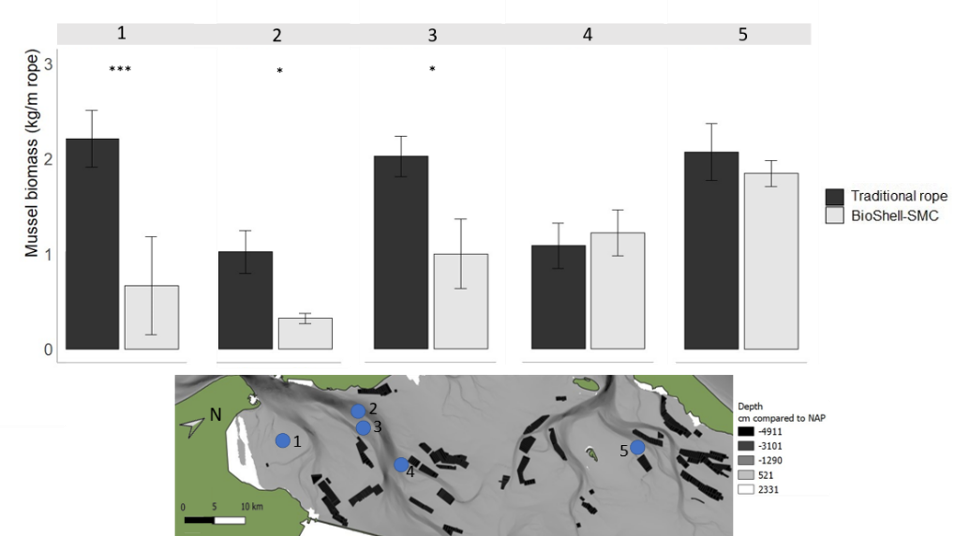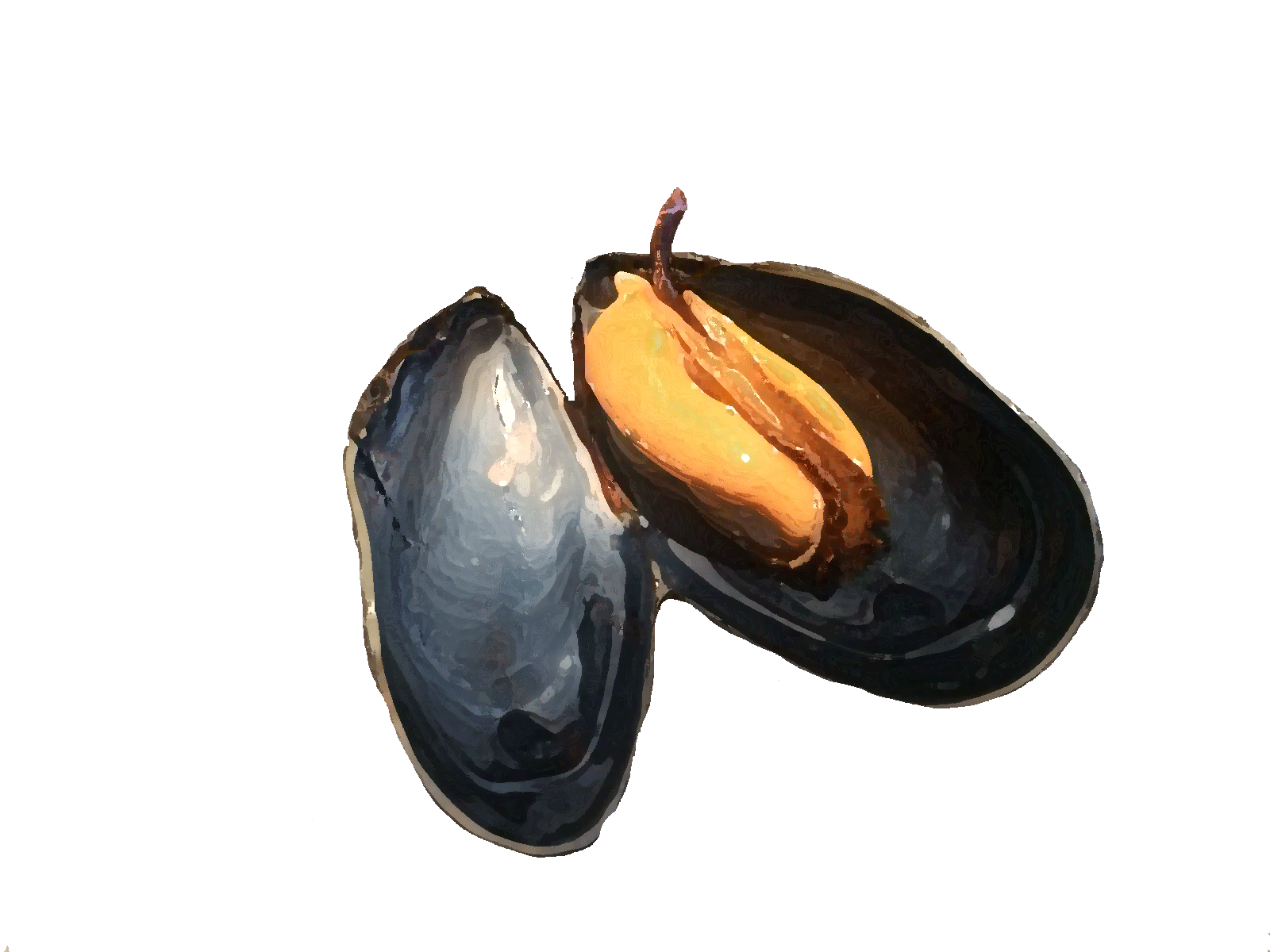Mussel farming typically begins with the collection of mussel seed, traditionally obtained by fishing mussel beds on the seafloor. In response to environmental concerns surrounding this practice, an agreement was reached in the Netherlands in 2009 between mussel farmers, nature organizations and the government to phase out bottom fishing. This resulted in the introduction of the mussel seed collector (MZI), a sustainable alternative that captures mussel seed from the water column and gradually replaces traditional bottom fishing for this purpose. However, seed collected with MZIs is more expensive (5 to 6 times) than traditional bottom fishing because of the additional effort and materials required. Achieving economic feasibility benefits from improving the survival of mussel seed collected with MZIs. The vulnerability of juvenile mussels to predation and washout is a major concern and results in significant losses immediately after seeding. In addition, there are environmental concerns about the materials used in MZIs, as these materials are usually of synthetic origin. What is important is the need to increase mussel survival rates after seeding, increase cost-effectiveness and promote environmental friendliness.
In this study (BioCollect), we investigated whether the use of biodegradable structures could increase mussel seed capture and survival. The structures we used, the “BioShell-SMC,” contain no plastics but consist of a biodegradable net based on a compound of aliphatic polyesters, filled with empty cockle shells around a rope of coconut fibers (Figure 1). We looked at several aspects of the BioShell-SMC, which are discussed paragraph by paragraph below.

Fig.1. The BioShell-SMC. Consists of a biodegradable net based on a compound of aliphatic polyesters, filled with empty cockle shells around a rope of coconut fibers.
Collection of mussel seed
Mussel larvae prefer to settle on complex surfaces that provide protection from currents and feeding. Empty shells are complex surfaces that have been shown to provide a suitable attachment substrate for mussel larvae. Therefore, the BioShell-SMC filled with empty clamshells could be a promising innovation for clam capture. We compared the effectiveness of the BioShell-SMC for mussel seed capture with traditional nylon MZIs. The results showed that both collector types produced similar mussel seed biomass at six of the nine sites (Figure 2). The choice of capture location did matter for this, as the more flow-exposed areas resulted in higher biomass for the traditional ropes. This difference was possibly explained by mussel seed being damaged under harsh environmental conditions by friction from the shell fragments in the BioShell-SMC. In addition, the results showed that the number of mussels decreased over time, while the total biomass increased. Therefore, finding the right timing is crucial for optimizing mussel biomass yields.


Fig. 2 Mussel biomass on traditional MZI (XMas Tree, dark gray) and BioShell-SMC (light gray) at five sites in the Wadden Sea (top) and four sites in the Eastern Scheldt (bottom). 1: Zuidwal, 2: Burgzand, 3: Vogelzand, 4: Gat van Stompe, 5: Zuidmeep, 6: Neeltje Jans, 7: Schaar van Colijnsplaat, 8: Vuilbaard, 9: Vondelinge.
Mussel seed sowing
Once the mussel seed is collected, it can be moved to a cultivation plot. Finding the optimal timing and method for sowing mussel seeds is crucial to increasing their chances of survival. We conducted a field experiment on a mussel plot in the Eastern Scheldt to compare the survival of mussels when attached to the BioShell-SMC compared to loose mussels. The results showed that larger clam seed (bustal: 460) had better survival when attached to BioShell-SMCs compared to loosely seeded clams (Figure 3). Predation and current were important factors contributing to the higher losses among loose mussels. For smaller mussels (bustal: 3000), there was a significant decrease in biomass during the first three days of the experiment, both in the loose mussels and in the mussel seeds attached to the BioShell SMCs. This decrease could be attributed to the small size of the mussels combined with relatively low densities due to the small scale of the experiment, which made them vulnerable to predation by crabs.

Fig. 3 Mussel biomass in the plots. Yellow: loose mussels, blue: open-cut net, gray: intact net.
Aggregation behavior
However, the major drawback of the BioShell-SMC may be that mussel densities are initially high, leading to competition for food and space, which hinders the growth and condition of the mussels. It is hypothesized that the clam shells in the BioShell-SMC may disperse over the surrounding substrate when the biodegradable net dissolves, facilitating the migration of clams as a strategy to avoid the intense competition. Therefore, we examined the behavior of mussels attached to the BioShell-SMC to better understand their ability to move to the surrounding substrate. In an experiment, we compared aggregation, survival and growth between loosely seeded mussels and mussels attached to the BioShell-SMC at different densities and sediments (hard versus soft) (Figure 4).

Fig. 4 Example of how the loose mussels (left) and the mussels in the BioShell-SMC (right) spread over the sediment after 30 days.
As expected, the results showed that mussels attached to the BioShell-SMC showed more clustering compared to loose mussels, especially at low density. Mussels in high density attached to the BioShell-SMC dispersed from the SMC on both hard and soft substrate, although we found a tendency toward more clusters on hard substrate. Mussels transplanted loosely formed clusters with higher biomass on soft sediment than in hard sediment situations. This suggests that mussels on soft sediment climbed on top of each other to reach favorable positions, while those on hard sediment were able to occupy more space by attaching to the substrate. In addition, mussels on the BioShell-SMC showed higher survival rates and had better condition than loose mussels.
Spatial patterns
Finally, we wanted to use the BioShell-SMC to create large-scale spatial patterns similar to the spatial organization of natural mussel beds; these patterns are known to increase their resilience (Figure 5). In a large-scale field experiment, we tested whether different spatial configurations (low versus high density labyrinth pattern and band pattern) could increase mussel seed sowing success. Results showed high mussel losses (~75% after nearly 300 days) in all configurations, with no significant variation. Mussels did not migrate off the substrate and thus did not disperse across the sediment. This led to high competition among the mussels present in high density on the BioShell-SMC, reducing survival. In addition, factors such as hydrodynamic runoff and burial probably contributed to the high losses.

Fig. 5 Aerial photograph of a mussel bed with a large-scale striped pattern in the Wadden Sea, located below Ameland. The mussel bed covers an area of about 1.2 hectares. Photo taken by Karin Troost on Feb. 19, 2019.
In conclusion, it appears that the use of degradable substrate for capture and seeding can contribute to mussel seed survival if applied at the right time, at optimal mussel densities and on a small scale (Figure 6). Future research should further investigate the optimal density of mussels attached to the BioShell-SMC and promote efforts for larger-scale use. This will require other seeding techniques to better spread the mussels and substrate.

Fig. 6 Summary figure with conclusions of the study.
The above is a summary of the doctoral research of Lisanne van den Bogaart (Utrecht University and NIOZ). The thesis with which she hopes to receive her doctorate in 2024 is entitled: “Muscle-up: enhancing mussel collection and transplantation success with a biodegradable material.”

